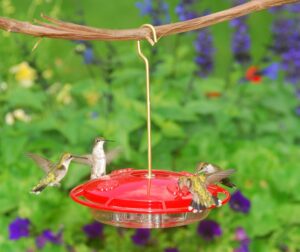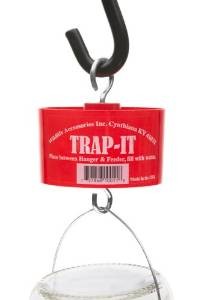If you use an ant moat you will keep ants out and your hummingbirds happy!
Hummingbird feeders are a beautiful addition to any garden, providing a constant source of nourishment for these tiny and colorful creatures. However, keeping them clean and functioning properly can be a challenge. One of the most common problems hummingbird feeder owners face is ants. These industrious insects are often drawn to the sweet nectar, but their presence can spoil the experience for both the birds and the feeder owner.
In this post, we’ll explore how you can keep ants away from your hummingbird feeders using ant moats. We’ll cover what ant moats are, how they work, and how you can create or purchase one for your hummingbird feeder. You’ll also learn why ants are attracted to hummingbird nectar and how to solve the problem for good.
What Are Ant Moats?
An ant moat is a simple but effective device used to keep ants away from hummingbird feeders. It works by creating a physical barrier between the ants and the feeder. Ant moats typically consist of a small, shallow container that is filled with water. When set up correctly, the moat prevents ants from reaching the nectar inside the feeder. Since ants cannot swim across the water, they are kept away from the sweet nectar that the birds love.
You can purchase an ant moat from most garden or bird supply stores. They come in many shapes and sizes, but all are designed to function in the same basic way. Some moats attach directly to the hummingbird feeder, while others may need to be installed on a hook or pole above the feeder.
DIY ant moat
Why Are Ants Drawn to Hummingbird Feeders?
Before we discuss how to keep ants out, it’s helpful to understand why they are so attracted to hummingbird feeders in the first place. Ants are drawn to sugary substances, so it makes sense that they would be attracted to the nectar in your hummingbird feeder.
Hummingbird nectar is often made of a simple mixture of water and sugar, which is very appealing to ants. Ants have a strong sense of smell and can detect sugar from a distance. They will follow the scent trail back to the source and often invade hummingbird feeders in search of food.
The challenge arises when ants not only invade the feeder but also infest the area around it. They can quickly ruin the experience for both the hummingbirds and the person trying to enjoy watching them. That’s where ant moats come in.
Make your own ant moat
Types of Ant Moats
There are several and each type has its advantages. Below, we’ll cover the most popular options.
1. Hanging Ant Moats
Hanging ant moats are designed to be attached directly to the hook or chain that holds your hummingbird feeder. These moats hang above the feeder, forming a barrier between the ants and the nectar. They are easy to install and often come in a variety of designs.
Hanging ant moats feature a small, plastic reservoir that holds water. Others may use a small metal container to hold the water, and these tend to look more decorative. Hanging ant moats are ideal for feeders that are suspended from trees, poles, or hooks.
2. Built-In Ant Moats
Some hummingbird feeders come with built-in ant moats. These feeders are specially designed with a moat integrated into the structure. A small reservoir is included around the base of the feeder, and you simply fill it with water to keep the ants away.
Built-in ant moats are convenient because they eliminate the need for additional accessories. If you’re buying a new feeder, look for models that already have this feature, as they will save you time and effort.
How Do Ant Moats Work?
The mechanism behind an ant moat is quite simple. Most moats work on the principle of preventing ants from crossing water. When an ant attempts to climb up to the feeder, it encounters the moat’s water-filled barrier. Ants are poor swimmers, and the moat prevents them from crossing.
The moat must be filled with water at all times to remain effective. Even if you’re using a hanging ant moat, be sure to check it regularly to make sure the water level hasn’t dropped due to evaporation. If the water level gets too low, ants may find a way around it.
For best results, choose a moat that is large enough to hold enough water to last for a few days. You don’t want to constantly refill the moat every time you check on your hummingbird feeder.
How to Install an Ant Moat
Installing an ant moat is easy. Here’s a step-by-step guide:
- Choose the Right Moat
Depending on your setup, choose either a hanging ant moat, if you already own a hummingbird feeder, or choose a feeder with a built-in ant moat. - Fill the Moat with Water
Once the moat is attached to the feeder, fill it with water. Make sure the water is deep enough to prevent ants from crossing. - Position Your Feeder Properly
For the moat to work effectively, you need to hang your feeder in a location where ants are unlikely to find an alternative route. Ideally, the feeder should be hanging from a pole or hook that is far from any structures, such as tree branches, that ants could use to crawl up to the feeder. - Check the Moat Regularly
Check the water level in your moat every few days, especially during hot weather when evaporation may cause the water level to drop. Keep the water fresh, and refill it as necessary. - Clean the Feeder
Ants are more likely to invade if your hummingbird feeder is dirty or sticky. Regularly clean your feeder with warm water and a mild soap solution to remove any sugar residue.
Here’s a comprehensive guide to help you clean your hummingbird feeder
Tips for Keeping Ants Away
While an ant moat is an effective way to keep ants away, there are other steps you can take to minimize the likelihood of ants invading your hummingbird feeder in the first place.
1. Clean the Feeder Regularly
Ants are attracted to sugar, and any spilled nectar or residue around the base of the feeder can act as a beacon for them. Make sure to clean your hummingbird feeder regularly to avoid attracting ants.
Use a bottle brush to clean the feeding ports and other areas of the feeder. Be sure to rinse it thoroughly before refilling with fresh nectar.
2. Place the Feeder on a Pole
Instead of hanging your feeder from a tree branch, consider placing it on a pole. This can help reduce the likelihood of ants crawling up to the feeder. If you place the feeder on a pole, make sure the pole itself is smooth and doesn’t provide a path for ants to climb.
3. Use Ant Repellent
If ants continue to be a problem, you can try using natural ant repellents around the base of the feeder. For example, cinnamon, peppermint oil, and vinegar are known to repel ants. Apply these substances to the area around the feeder to discourage ants from approaching.
4. Maintain a Clean Feeding Area
In addition to cleaning the feeder, keep the area around it clean. Sweep away any fallen leaves, sugar crystals, or spilled nectar. This will help reduce the chances of attracting ants in the first place.
One of the best Hummingbird feeders that’s easy to take apart and clean is the HummZinger Ultra.

Aspects 12oz HummZinger Ultra With Nectar Guard.
The HummZinger Ultra 12oz Saucer Feeder is one of the best options for a hummingbird feeder that’s both easy to clean and maintain. This top-tier feeder features patented Nectar Guard tips—flexible membranes on the feeding ports that keep flying insects out while still allowing hummingbirds to feed freely. Plus, it comes with an integrated ant moat to prevent crawling insects from reaching the nectar, and the raised flower ports help divert rain, keeping the nectar fresh.
With a 12 oz capacity, this mid-size feeder offers plenty of space and can be hung or mounted on a post using the included hardware. It has four feeding ports and is made from durable, unbreakable polycarbonate. Whether you’re concerned about bees, wasps, or ants, this feeder is built for easy cleaning and insect protection.
If you already have a hummingbird feeder, and you want to protect it from ants and other crawling insects, the ant moat below will do the job.
Trap-It Ant Moat for Hummingbird Feeders
Using an ant moat for your hummingbird feeder is an effective way to keep ants away from the sweet nectar. These tiny creatures are drawn to

the sugar water, and without a barrier, they will quickly infest your feeder, preventing the birds from enjoying the nectar. An ant moat works by creating a barrier of water that ants can’t cross. Positioned above the feeder, it effectively blocks the ants’ path, keeping them from reaching the nectar.
This simple solution also ensures that your hummingbird feeder remains clean and accessible for the birds, rather than becoming a breeding ground for ants or other pests. It’s a small addition that can make a big difference in maintaining a healthy, inviting space for hummingbirds, while also reducing the need for chemical ant deterrents.
The first and still the best to protect your Hummingbird and Oriole feeder from ants and other crawling insects. Insert between hanger and feeder and fill with water, providing a barrier to crawling pests. Red color to attract hummingbirds.
|
Small bottle brushes and pipe cleaners are always helpful to dislodge mold inside the feeder and in the feeding ports. It is necessary to have a clean mold free feeder to attract hummingbirds and to keep them healthy. |
Conclusion
Ant moats are a simple yet effective way to keep ants away from your hummingbird feeder. Whether you choose a hanging moat, a built-in moat, or a clip-on option, you can enjoy watching hummingbirds without the frustration of dealing with ants. Regular maintenance, along with a clean feeding area and a properly filled moat, will ensure your feeder stays ant-free.
By keeping your hummingbird feeder free of ants, you’ll create a more enjoyable environment for both the birds and yourself. With just a little effort, you can ensure that your hummingbirds are able to enjoy their nectar without the interference of ants.
Happy bird watching!
Resources
U.S. Fish and Wildlife Service – Hummingbird Conservation
This site offers detailed information about various hummingbird species, their habitats, and conservation efforts. It also provides resources on how to protect these fascinating birds.
National Park Service – Hummingbird Resources
The National Park Service offers insights into hummingbird species found in national parks, their behaviors, and their role in ecosystems, along with tips for observing them.
 your hummingbird feeder regularly to avoid attracting ants.
your hummingbird feeder regularly to avoid attracting ants.
